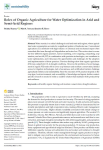Sharma S., Yost M.A., Reeve J.R. (2025). Roles of organic agriculture for water optimization in arid and semi-arid regions. Sustainability, 02/06/2025, vol. 17, n. 12, p. 5452.
http://doi.org/10.3390/su17125452
http://doi.org/10.3390/su17125452
| Titre : | Roles of organic agriculture for water optimization in arid and semi-arid regions (2025) |
| Auteurs : | S. Sharma ; M.A. Yost ; J.R. Reeve |
| Type de document : | Article |
| Dans : | Sustainability (vol. 17, n. 12, June 2025) |
| Article en page(s) : | p. 5452 |
| Langues : | Anglais |
| Langues du résumé : | Anglais |
| Catégories : |
Catégories principales 07 - ENVIRONNEMENT ; 7.3 - Eau. Gestion de l'EauThésaurus IAMM GESTION DES EAUX ; METHODE D'OPTIMISATION ; CONSERVATION DE L'EAU ; AGRICULTURE BIOLOGIQUE ; ZONE ARIDE ; CLIMAT ARIDE ; CLIMAT SEMI ARIDE |
| Résumé : | Water scarcity is a critical challenge in arid and semi-arid regions, where agricultural water consumption accounts for a significant portion of freshwater use. Conventional agriculture (CA) methods with high reliance on chemical and mechanical inputs often exacerbate this issue through soil degradation and water loss. This review aims to examine how different organic practices, such as mulching, cover cropping, composting, crop rotation, and no-till (NT) in combination with precision technologies, can contribute to water optimization, and it discusses the opportunities and challenges for the adoption and implementation of those practices. Previous findings show that organic agriculture (OA) may outperform CA in drought conditions. However, the problems of weed management in organic NT, trade-offs in cover crop biomass and moisture conservation, limited access to irrigation technologies, lack of awareness, and certification barriers challenge agricultural resilience and sustainability. Since the outcomes of OA practices depend on the crop type, local environment, and accessibility of knowledge and inputs, further context-specific research is needed to refine a scalable solution that maintains both productivity and resilience. |
| Cote : | En ligne |
| URL / DOI : | http://doi.org/10.3390/su17125452 |







